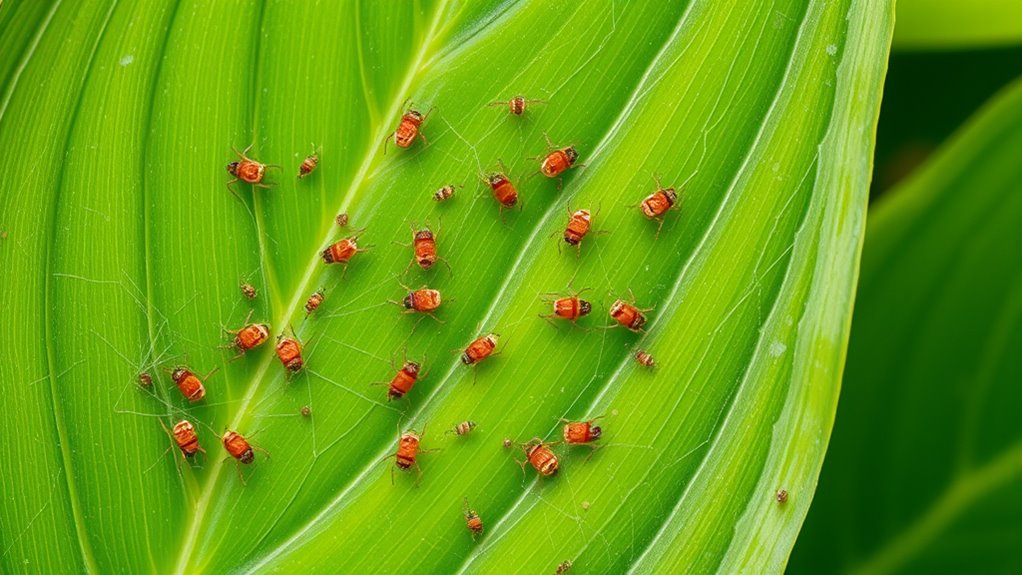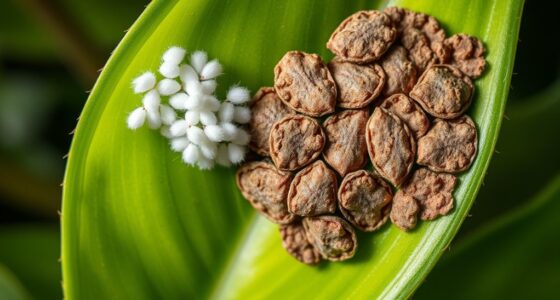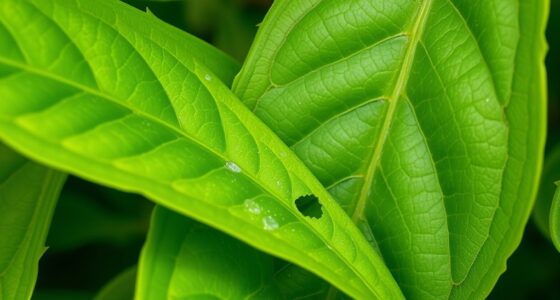If you notice tiny specks, webbing, or discolored leaves on your indoor plants, spider mites are likely the culprit. These pests thrive in dry, warm environments and often hide under the leaves’ undersides. To control them, you can introduce natural predators like ladybugs, use insecticidal soaps, or increase humidity to make conditions less inviting. Want to discover more effective ways to protect your plants? Keep exploring to get all the essential tips.
Key Takeaways
- Look for tiny specks, webbing, and discolored leaves, especially on undersides of indoor plant leaves.
- Maintain high humidity and proper airflow to prevent spider mite infestations.
- Use natural predators like ladybugs or predatory mites early to control spider mite populations.
- Apply insecticidal soaps or horticultural oils thoroughly on affected areas, reapplying as needed.
- Regularly inspect and clean plants, prune infested parts, and avoid over-drying to keep mites at bay.

If you notice tiny specks or webbing on your indoor plants, you might be dealing with spider mites. These tiny pests are often hard to spot at first, but their presence becomes obvious through fine webs and speckled, discolored leaves. Spider mites thrive in dry, warm environments, making indoor plants especially vulnerable. The first step is to confirm their presence by inspecting the undersides of leaves and stems for tiny moving dots or silky threads. Once you’re sure, you need to act quickly to prevent a full-blown infestation.
One effective way to combat spider mites is by introducing natural predators. Certain predatory insects, like ladybugs or predatory mites, feed on spider mites and can serve as a biological control method. These natural predators are safe for your plants and the environment, making them a preferred choice over chemical treatments. Releasing these beneficial insects can reduce the mite population gradually and sustainably. Keep in mind, however, that natural predators work best when the infestation is caught early and can be combined with other control methods for *ideal* results.
Introducing natural predators like ladybugs and predatory mites can safely and effectively control spider mite infestations.
If you prefer a faster solution or if the infestation has become severe, chemical treatments are available. You can use insecticidal soaps or horticultural oils, which are less harsh and target spider mites effectively. Always follow the instructions carefully to avoid damaging your plants. Spray the affected areas thoroughly, focusing on the undersides of leaves where mites tend to hide. Reapply as directed, usually every few days, until you see a decline in mite activity. Be cautious with chemical treatments, as overuse can harm beneficial insects and possibly your plant’s health. Always prioritize less invasive options first, reserving chemical solutions for stubborn infestations.
Alongside biological and chemical controls, maintaining proper plant hygiene can help prevent future outbreaks. Regularly wipe down leaves, increase humidity, and avoid over-drying your indoor environment. Proper watering and good airflow discourage spider mites from settling in. Additionally, pruning heavily infested parts can physically remove many pests and their webs, giving your plant a fresh start. Using self watering plant pots can help maintain consistent moisture levels that discourage mite infestations. Consistency is key—monitor your plants frequently to catch early signs of trouble and act promptly.
Dealing with spider mites may require some effort, but with the right combination of natural predators and chemical treatments, along with good plant care, you can effectively manage and eliminate these pests. Keep a close eye on your plants, act swiftly at the first sign of trouble, and your indoor garden will thrive free of spider mites.
Frequently Asked Questions
Can Spider Mites Spread Between Different Types of Indoor Plants?
Yes, spider mites can spread between different types of indoor plants through cross species transmission. They often hitch a ride on shared tools, your hands, or even air currents, making infestation prevention challenging. To avoid spreading, always disinfect your tools and keep plants apart if you notice mites. Regularly inspecting your plants helps catch infestations early, reducing the risk of cross species transmission and keeping your indoor garden healthy.
Are Certain Indoor Plant Species More Susceptible to Spider Mite Infestations?
Some indoor plants are more susceptible to spider mite infestations due to their plant susceptibility and pest preference. Plants with fine, tender leaves, like ferns or African violets, attract spider mites more easily. You should monitor these plants closely, as their susceptibility makes them prime targets. Regular inspection and proper care help reduce pest preference and protect your plants from severe infestations.
What Are Natural Predators of Spider Mites Suitable for Indoor Use?
You can use beneficial insects like predatory mites, ladybugs, and lacewing larvae for natural pest control methods against spider mites. These beneficial insects target and feed on spider mites, helping you manage infestations indoors without chemicals. Introduce them carefully according to instructions, and guarantee your plants provide a suitable environment for their survival. Using beneficial insects is an eco-friendly way to keep your indoor plants healthy and free of pests.
How Do Environmental Changes Indoors Affect Spider Mite Populations?
Imagine your indoor space as a delicate balance, where humidity control and temperature fluctuations act like unseen hands shaping spider mite populations. When you increase humidity or stabilize temperatures, you create an environment less inviting for these pests. Conversely, dry air and fluctuating temperatures can boost their numbers, making infestations worse. By maintaining consistent, moderate conditions, you help keep spider mites at bay, safeguarding your indoor garden’s health.
Are There Long-Term Health Effects for Humans From Spider Mite Infestations?
Long-term health risks from mite allergen exposure are generally low for most people, but some may develop allergies or asthma symptoms over time. If you’re frequently exposed to mite allergens, you might notice persistent respiratory issues, especially if you have existing sensitivities. To minimize risks, keep your indoor plants clean and well-maintained, and consider using air purifiers. Regularly monitoring your health helps catch any reactions early.
Conclusion
Dealing with spider mites is like fighting a tiny army on your plants. Stay vigilant, regularly check your indoor greenery, and act quickly if you spot signs of infestation. Use natural or chemical treatments as needed, and keep humidity high to discourage these pests. With consistent care, you’ll keep your plants healthy and vibrant. Remember, a proactive approach is your best defense—think of yourself as a plant’s superhero, saving it from unseen invaders.









